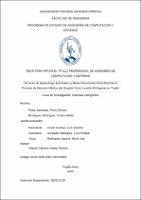Mostrar el registro sencillo del ítem
Técnicas de aprendizaje automático y redes neuronales para priorizar el proceso de atención médica del Hospital Víctor Lazarte Echegaray en Trujillo
| dc.contributor.advisor | Abanto Cabrera, Heber Gerson | |
| dc.contributor.author | Pulce Janampa, Tomy Gerson | |
| dc.contributor.author | Rodríguez Rodríguez, Carlos Wilder | |
| dc.creator | Pulce Janampa, Tomy Gerson | |
| dc.date.accessioned | 2024-02-12T17:40:07Z | |
| dc.date.available | 2024-02-12T17:40:07Z | |
| dc.date.issued | 2024 | |
| dc.identifier.uri | https://hdl.handle.net/20.500.12759/21111 | |
| dc.description.abstract | En base a un estudio que se realizó en el Perú, se identificó que la atención en los hospitales se veía afectada por largas filas, lo que ocasionaba largas horas de espera para obtener una cita y ser atendidos, o incluso no obtener una cita. Durante la pandemia del Covid-19, el Centro Nacional de Telemedicina atendió más de un millón de consultas virtuales en todo el país, generando cerca de 160,000 citas médicas en línea en el mes de junio. También se comprobó que, en el sector privado, aproximadamente el 33% de los asegurados rechazaba o posponía citas médicas virtuales debido a la desconfianza en el medio o la falta de conocimiento en tecnología. El Hospital ““Víctor Lazarte Echegaray““ presentaba problemas en la asignación de consultorios, médicos y personal de apoyo, lo que dificultaba la asignación adecuada de citas según la prioridad de cada paciente. Esta situación se reflejaba en protestas por parte del personal médico y denuncias de los pacientes. El objetivo general de la investigación fue desarrollar un software basado en redes neuronales que priorizara el proceso de atención médica en el Hospital Víctor Lazarte Echegaray, utilizando técnicas de aprendizaje automático para la asignación de citas médicas. También se plantearon objetivos específicos, como el análisis del estado del arte en técnicas de procesamiento de datos, la limpieza y preparación de los datos para el entrenamiento del modelo de red neuronal, el establecimiento de reglas para la asignación de citas y la integración del software con la red neuronal entrenada. La implementación de un sistema basado en redes neuronales y aprendizaje automático mejoró la asignación de prioridad a los pacientes y redujo el diferimiento de citas médicas en el Hospital Víctor Lazarte Echegaray. Esta investigación abordó con éxito un problema crítico en la atención médica y mejoró significativamente la calidad de los servicios de salud en el hospital mencionado. | es_PE |
| dc.description.abstract | Based on a study conducted in Peru, it was identified that healthcare in hospitals was adversely affected by long queues, resulting in extended waiting times to secure appointments, or even the failure to obtain an appointment. During the Covid-19 pandemic, the National Telemedicine Center attended to over a million virtual consultations across the country, generating approximately 160,000 online medical appointments in the month of June. It was also found that in the private sector, approximately 33% of insured individuals rejected or postponed virtual medical appointments due to distrust in the medium or a lack of technological knowledge. The ““Víctor Lazarte Echegaray““ Hospital faced challenges in the allocation of consulting rooms, medical personnel, and support staff, which hindered the proper assignment of appointments based on each patient's priority. This situation manifested in protests by medical staff and patient complaints. The general objective of this research was to develop a neural network-based software that prioritized the medical care process at the Víctor Lazarte Echegaray Hospital, using machine learning techniques for the allocation of medical appointments. Specific objectives included conducting a state-of-the-art analysis of data processing techniques, data cleaning and preparation for neural network model training, establishing rules for appointment allocation, and integrating the software with the trained neural network. The implementation of a system based on neural networks and machine learning improved the prioritization of patients and reduced the deferral of medical appointments at the Víctor Lazarte Echegaray Hospital. This research successfully addressed a critical issue in healthcare and significantly enhanced the quality of healthcare services at the mentioned hospital | es_PE |
| dc.description.uri | Tesis | es_PE |
| dc.format | application/pdf | es_PE |
| dc.language.iso | spa | es_PE |
| dc.publisher | Universidad Privada Antenor Orrego | es_PE |
| dc.relation.ispartofseries | T_SIST_1532 | |
| dc.rights | info:eu-repo/semantics/embargoedAccess | es_PE |
| dc.rights.uri | https://creativecommons.org/licenses/by/4.0/ | es_PE |
| dc.source | Universidad Privada Antenor Orrego | es_PE |
| dc.source | Repositorio Institucional - UPAO | es_PE |
| dc.subject | Atencion Medica | es_PE |
| dc.subject | Asignacion de Citas | es_PE |
| dc.title | Técnicas de aprendizaje automático y redes neuronales para priorizar el proceso de atención médica del Hospital Víctor Lazarte Echegaray en Trujillo | es_PE |
| dc.type | info:eu-repo/semantics/bachelorThesis | es_PE |
| thesis.degree.level | Título Profesional | es_PE |
| thesis.degree.grantor | Universidad Privada Antenor Orrego. Facultad de Ingeniería | es_PE |
| thesis.degree.name | Ingeniero de Computación y Sistemas | es_PE |
| thesis.degree.discipline | Ingeniería de Computación y Sistemas | es_PE |
| dc.subject.ocde | https://purl.org/pe-repo/ocde/ford#2.02.04 | es_PE |
| renati.advisor.orcid | https:// orcid.org/0000-0001-9320-806X | es_PE |
| renati.author.dni | 41514340 | |
| renati.author.dni | 18202654 | |
| renati.advisor.dni | 18107335 | |
| renati.type | https://purl.org/pe-repo/renati/type#tesis | es_PE |
| renati.level | https://purl.org/pe-repo/renati/level#tituloProfesional | es_PE |
| renati.discipline | 611066 | es_PE |
| renati.juror | Urrelo Huiman, Luis Vladimir | |
| renati.juror | Alvarado Rodríguez, Luis Enrique | |
| renati.juror | Rodríguez Aguirre, Silvia Ana | |
| dc.publisher.country | PE | es_PE |
| dc.date.embargoEnd | 2028-02-12 |





